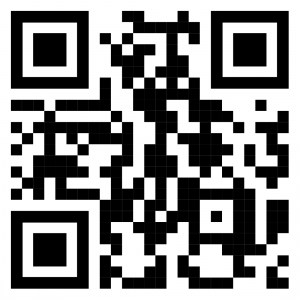What does a freezer full of underwear, 2,914 Nautical Miles and a little red rubber boat have in common? A remote island in the middle of the Pacific called Baker Island National Wildlife Refuge.
Planning:
The Dateline DX Association was founded in 1995 to mount a DXpedition to Wake Island. Two years later members again went to KH9, and in subsequent years members have operated from many places along the Dateline in the Pacific. Our previous Dxpedition, in 2009, was to Midway Island, also along the Dateline. During these trips we demonstrated to the relevant agencies our stewardship of the fragile ecosystems in these locations. In 2015, we contacted the United States Fish and Wildlife Service (USFWS), Pacific Island Refuges and Monuments Office, seeking permission to operate from Howland Island. After a year and a half we were asked to withdraw our application for Howland pending news of an opportunity for Baker Island National Wildlife Refuge (Baker), which we did. We also continued to work with USFWS on standards and suggestions for a compatibility determination.
In late April of 2017, the USFWS released a “draft compatibility determination for Amateur Radio operations on Baker Island.” The public comment period ended May 8, and the FWS received some 24 e-mails in support of a DXpedition to Baker Island National Wildlife Refuge, none opposing, and four applications were received for operations from KH1.
In early July 2017, the Pacific Islands Refuges and Monuments Office of the USFWS selected the Dateline DX Association to conduct an Amateur Radio DXpedition to Baker and issued Special Use Permit number 12511-18001. This was a sound choice based on the group’s successful operations from other USFWS locations. The team was very well known to USFWS Hawaii based personnel and provided a lot of input to them on safe Amateur Radio operations from sensitive environmental locations.
The co-leaders for this DXpedition were Don Greenbaum, N1DG; Tom Harrell, N4XP, and Kevin Rowett, K6TD. We quickly added team members from past Dateline operations, mostly veterans of the aforementioned Midway expedition and other Pacific operations. We formed teams for boat selection, antennas, radios, IT infrastructure and fund raising. Many others who would not make the trip also volunteered with logistics, propagation forecasting and equipment loans. A website domain of baker2018.net was chosen, K6MM built a website, and we were off and running.
The Baker Island NWR consists of Baker Island and all surrounding waters within 12 nautical miles of the island. The island itself is only .81 square miles, roughly ¾ mile by 1 mile. The USFWS website 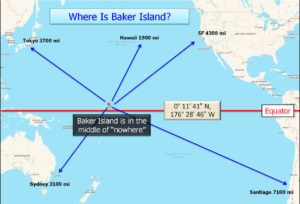 describes Baker Island as “the crest of an ancient steep-sided coral reef cap and massive underlying extinct volcano emerging from the deep ocean floor of the equatorial Pacific. The equatorial undercurrent deflects off the western flank of the seamount, pushing nutrient-rich waters up into the sunlit zone, thereby increasing marine productivity and benefiting many species of marine life. This phenomenon only exists on Baker, Howland, Jarvis and a few other Pacific equatorial islands.” It is treeless, very hot and humid. We were told it rarely if ever rains in June and July.
describes Baker Island as “the crest of an ancient steep-sided coral reef cap and massive underlying extinct volcano emerging from the deep ocean floor of the equatorial Pacific. The equatorial undercurrent deflects off the western flank of the seamount, pushing nutrient-rich waters up into the sunlit zone, thereby increasing marine productivity and benefiting many species of marine life. This phenomenon only exists on Baker, Howland, Jarvis and a few other Pacific equatorial islands.” It is treeless, very hot and humid. We were told it rarely if ever rains in June and July.
Baker and Howland Islands are best known as the destination in 1937 of the ill fated Amelia Earhart journey. A little known fact about the island is that in 1935 Hawaii sent teams of recently graduated high school students to Howland, Baker and Jarvis Islands to colonize them. They eked out a meager existence in these harsh environs until 1942, when they were evacuated because of the danger of the war years. We decided early on to commemorate these brave pioneers on this DXpedition. Full details of both these events are found on our website, www.baker2018.net.
The KH1 DXCC entity, Baker and Howland Islands, ranked number five worldwide on Club Log’s Most Wanted List. The last DXpedition to KH1 was K1B on Baker Island in May 2002. It had been the only major DXpedition to Baker. AH1A was the only major DXpedition to Howland in 1993. Both DXpeditions were made during solar cycle highs. This would be the first during a solar minimum. Yet, demand was high and given the time it took to obtain the permit the window for going during an active sunspot period had passed.
Our permit was contingent on finding an acceptable vessel (to us and USFWS), a date when the Pacific Islands Refuges and Monuments Office of USFWS could send a resource monitor and approval of the team of hams chosen. The operating dates would also depend on sea and landing conditions. The permit also limited the team to 11 permanent ops on the Baker Island reserve so 3 of the team would be on the ship and members would rotate on and off as surf conditions allowed.
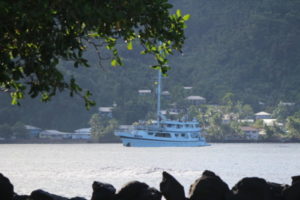 Regarding Special Use Permits, they allow for one activity. Our permit was specific to “Amateur Radio Operation.” If we wanted to dive and look at the fish, that’s another permit. Swim? Take a professional video? Beach volleyball? Those are all separate permits.
Regarding Special Use Permits, they allow for one activity. Our permit was specific to “Amateur Radio Operation.” If we wanted to dive and look at the fish, that’s another permit. Swim? Take a professional video? Beach volleyball? Those are all separate permits.
After a month of searching, a very experienced vessel out of Fiji called the Nai’a was chosen. The Nai’a had been to this area many times on searches for Amelia Earhart and was very experienced with a crew that could safely get us on the island, help move the tons of equipment to the stations, and provide food on a daily basis.
The team of DXers on this trip included many veterans of prior DXpeditions. 9V1YC, AA7A, AA7JV, HA7RY, JN1THL, KN4EEI, K6MM, K6TD, N1DG, N4HU, N7CW, N6HC, VA7DX and WJ2O had all been to rare and environmentally sensitive locations. More importantly many had travelled together on past trips so we knew each other’s habits and operating skills.
Equipment:
The radios of choice for this harsh environment were Elecraft K3S transceivers, Elecraft eagerly agreed to loan us 8 radios and 8 KPA500 linears. They would be proven to be ironclad. None of these radios failed in the heat. NONE.
DXEngineering provided all the coax, connectors,tape, fiberglass poles, RX antenna supports, etc. Anything we needed was just a phone call away!
The USFWS permit dictated that no antennas could be higher than 43 ft and only guyed verticals were allowed. This challenged the engineering talents of the team and we assigned George, AA7JV, the well known low-band DXpeditioner, to design efficient verticals for all bands. During the winter before our trip George built some 2 element phased verticals for the HF bands, a vertical for 160M with a tuner that would compensate for changing tide levels, and a “fat” 80M vertical that would also tune on 80, 40 and 30 meters. The idea was to get the low band verticals as close to the water mid tide level (which meant IN THE WATER at high tide).
In addition to George’s homemade verticals, we contacted SteppIR antennas for 3 big IR and 3 small IR antennas to ensure all radios had flexibility on many bands. The SteppIR verticals allowed us to operate up to 8 radios at a time. Like the Elecraft radios, we had no antenna failures due to electronics (storms were to be a different matter).
Operating in tents with operators close to one another requires headsets with good noise rejection. Bob Heil outfitted the team with the latest Pro7 Headsets that also were useful in eliminating local environmental QRN/M (birds!).
Among other important donors, Rig Expert provided their AA-54 Antenna analyzers which made antenna building a snap and UX5UO Print provided our QSL cards that are now being received all over the world.
IT:
Ned, AA7A, was assigned to be our IT guy. We decided early on to network the stations as they would be separated by 100-200 meters to reduce station interference. This allowed for communications between stations and easy log collection. We used N1MM+ as our logging software. We also were planning on experimenting with remote operation from the boat for the ops staying there overnight.
With the low sunspots, remote location of Baker to Europe, and the desire to operate on 12, 10 and 6 meters we planned on integrating FT8 into our mode plan to take advantage of weak signal opportunities. FT8 is also a faster digital mode to work than RTTY. The team went one step further and contacted Joe Taylor about the possibility of adding a DXpedition mode to WSJT-X that would allow us to work more stations faster. As the fall of 2017 progressed the idea of a multi-stream fox/hound option took shape and the WSJT-X team released beta versions of what today is known as version 1.9.1 with fox/hound modes. Our last on-the-air test in May 2018 demonstrated this was a stable and reliable software version and it performed flawlessly once on the island.
Biological protocol:
An important consideration to the team, USFWS, and our permit was the protection of the environment. Our ship was subject to inspection in Pago Pago after a thorough hull cleaning. Everything not made of plastic or metal had to be frozen for 48 hours and put in sealed bags. All clothes going to the island had to be purchased new before freezing. Our wives are used to all sorts of radio shenanigans from us. Filling the freezer with underwear must take the cake. All used antennas, tent poles, masts etc had to be thoroughly cleaned and sealed. The goal was that no seeds or insects be brought to the island by us. Our diet was restricted to foods without seeds as well. We are confident that we left no new species on the island.
Finance:
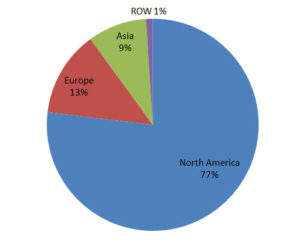
Visiting a remote DX location like Baker Island National Wildlife Reserve is an expensive undertaking. Our final expenses topped $470,000; 50% of this cost was underwritten by the team members. The Northern California DX Foundation made a substantial grant of $75,000 to this undertaking. Other US clubs and foundations donated $25,000, and foreign clubs added $12,500 in total funding. Another $24,000 came in from then until we turned on OQRS. Lastly, $32,000 was contributed by OQRS fees (as of the date of this article, 45 days after turning on OQRS). Without the support of foundations and clubs, expensive DXpeditions to rare locations just would not take place because of timing. Most of the expenses occur before the teams leave home. Our sources of funding were:
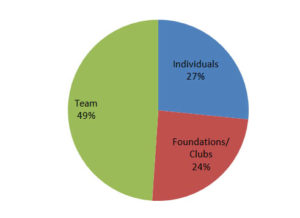
MDXC was the only Italian DX Club to contribute to our efforts. Total Italian contributions (with individuals, pre and post operations) totaled $2,953 or 1% of our total non team funding. Italian stations also made 2.1% of the total QSOs, 1,433Q in total with 746 unique callsigns. MDXC members made 480 of those QSOs.
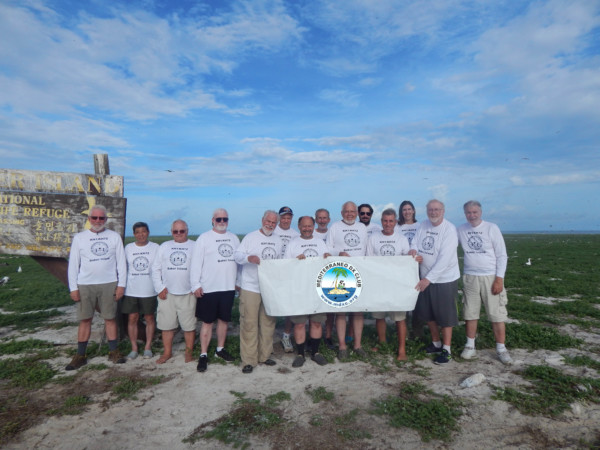
Thank you MDXC DX Club !
The Dateline DX Association is a firm believer in disclosing all finances to the DX community. We hope others will join us in this full disclosure effort.
Testing:
All equipment was assembled and tested in April. The tents were built in Georgia to ensure all parts were there while the radios/amps/network/software/antennas were deployed and thoroughly tested at K6TD’s QTH in California after the International DX Convention in Visalia. It should be noted that once on Baker, every station, antenna, PC, tent etc was deployed without failure and stayed deployed until we left, a testimonial to good planning and quality of the equipment we took.
Getting there and setting up:
An advance team arrived in Fiji to move our 5,800 pounds of gear air freighted from San Francisco and move it from the forwarder and onto the Nai’a. They also purchased last minute supplies. Then the Nai’a sailed to Pago Pago on the 15th of June. Team members travelled from 3 continents and 5 countries to assemble on June 19th in Pago Pago to board the Nai’a and depart on the morning of the 20th of June. Before departure we had a final meeting with the team, ship crew and USFWS personnel to go over setup plans, team assignments, and goals of our expedition. We also had a safety briefing from the crew, and upon boarding the ship we had the traditional Fiji welcome complete with songs from the crew. The Nai’a passed all inspections, cleared customs and immigration and off we went.
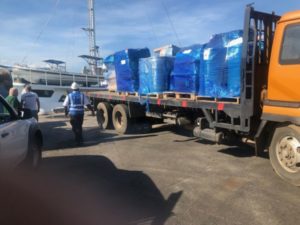
Our voyage was uneventful and we passed through the waters of Tokelau and Kiribas before entering the Reserve on the evening of the 24th. The team and crew then started pulling supplies out of the hold and pre staging the order of gear to be moved to the island. Tents for shelter and the 7 day survival food and water were first. At daybreak we had our first sighting of the day beacon on Baker and a warm welcome from the inhabitants, millions of birds!
At daybreak captain Rob and several of his crew went ashore to test the passage and landing procedure. The channel that the military had carved through the reef in the 1950s was long gone. Probably a good thing as 11 landing craft was lost. It was a learning curve for them and us. It should be noted that over the next 10 days not one piece of gear went into the water (not the same for our team and crew) and no one was hurt getting on and off the beach. You can view a video of our landing procedure at https://youtu.be/zuqLeO_B5Pg.
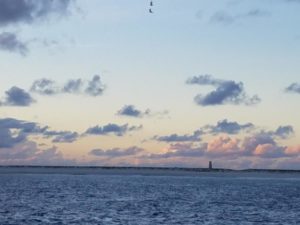 Notice the skiff in the video? Rob, the boat owner, consulted with the NOAA people about the best way on the island. Rob’s wife, Cat, pointed out that where many men during a mid-life crisis trade in their luxury Lexus or Audi for a spirited red Porsche, Rob bought a little rubber boat!
Notice the skiff in the video? Rob, the boat owner, consulted with the NOAA people about the best way on the island. Rob’s wife, Cat, pointed out that where many men during a mid-life crisis trade in their luxury Lexus or Audi for a spirited red Porsche, Rob bought a little rubber boat!
The advance team of Kevin K6TD, George, AA7JV, Don, N1DG, James 9V1YC and Allie FWS were on the island by 7:30 AM local time. The landing was not too bad, but the weather on Baker was brutal. By 10 AM it was well over 100 degrees and Baker has no trees so we worked in direct sun. The tide was rapidly getting rough as well but the Nai’a crew got all the tents, generators and emergency food and water supplies with Mike, KN4EEI, Rick, N4HU, Arnie, N6HC, and Tomi, HA7RY, on the beach before the surf cut off access for the morning. This team put up the operating tents and main meeting tent, and set up the basic camp layout. Members of the ship’s crew dug a hole for the latrine (taking care of number 2 was job number 1).
At 2 PM, the high tide allowed reinforcements to arrive with fresh energy and the totally exhausted original landing team departed. This new group put up the sleeping tents and moved radios, antennas and generators to the storage and operating tents. Most of the equipment, fuel, water and emergency food needed for the expedition was now safely on the island and distributed.
By sunset, everyone was off the island so we could rest up. A hearty meal was had by all and shortly after sunset ship was eerily quiet. By 7 am Day 2 team members were again headed to the island. Antenna building was the number one priority before the sun got too hot and by lunch there were two antennas up in the CW area (160M and the 80/40/30M antennas). The SSB tent had a big IR ready for action. Once the day got too hot on the beach, the radios, generators and network operations took place and by sunset on the 27th we had three stations operating. The team was exhausted but ecstatic that we were operating ahead of schedule. All but 2 of the team slept on the island.
Our joy at the speed of our setup came to a halt around midnight local time when a major squall came onshore from the West accompanied by a nasty tide. So much for the assurances that it never rains on Baker in June! The low band antennas at the water’s edge were no match for the water as the aluminum bases sheared off. After a four hour stint we were QRT in the operating tents while those who had gone to bed were now awake in their tents and holding them up for support.
Since we were on the island at first light we quickly moved all hands to repair the broken antennas and put up the full complement of SSB and CW antennas digital tent antennas and radios were set up. By sunset of Day three (June 28th) the complete camp was up and running and operations were in full swing. Our meals arrived from the ship at times the tides permitted and the team rotated back to the ship a few men at a time for showers and rest (keeping the full time contingent to 11 ops). Life for the next week would be like this.
By day 4 we had all 8 stations going, with team members taking four hour shifts. Digital operations began and the FT8 station on six meters was beaconing away (no contacts were ever made on six). Almost 11,000 QSOs would be made this day as conditions were good to all parts of the globe. Signals out of Western Europe were particularly strong and our decision to ALWAYS have two stations on 20M when the band was open paid off. We never missed a European opening. At one point during some days we had three stations on 20M as the good separation between the camps allowed FT8 to slip between the SSB and CW stations without interfering. In fact, the CW tent did more interfering with SSB than FT8.
Band conditions over the next five days declined slowly but we still averaged over 8,000 QSOs a day. The weather continued hot and humid around the clock and we often had afternoon and evening storms. Some were so strong that the ship had to leave the island and go out to sea to get away from the reefs. But none of these storms did any damage since we had moved the antennas away from the waterline and laid down more radials instead.
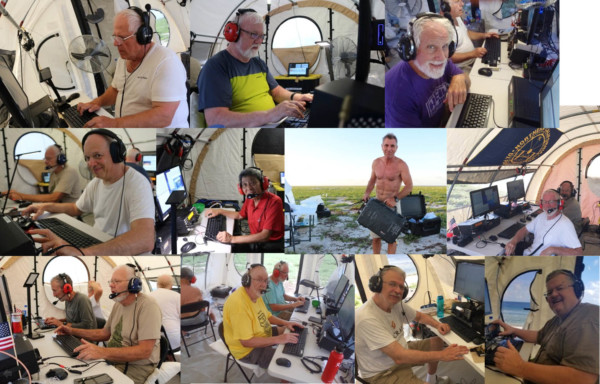
Why are these men smiling? They are doing what they like BEST!
On July 4th, after 7 1/2 days of operating, the captain warned us that a storm was approaching which would make getting off the island dangerous in 2 days. The decision was made to take down the low band antennas at sunrise on the 5th and pack a few of the stations during the day with the goal of consolidating the 3 operating tents into 2. The furthest station from the beach departure point was completely dismantled and moved off the island before sunset. Around midnight local time after the HF bands were all but closed, we went QRT (12 UTC 5 July).
At daybreak, with the Nai’a crew we tore down the rest of the stations, packed the remaining tents and spent the rest of the morning loading everything onto the beach for the crew to retrieve back to the ship. By early afternoon everything was aboard the Nai’a, and we began our homeward journey back to Fiji with the Baker Island dolphins leading the way. The storm as forecasted, created high seas and the return five day voyage had its share of rough waters. However, with almost 70,000 QSOs (18,100 uniques) under our belt and emails pouring in congratulating us on a fine job we enjoyed the voyage and especially the rest we all needed.
FT8:
Our use of FT8 during the DXpedition was both controversal when announced but very successful when implemented. Many curmudgeons have bemoaned the use of computers in making contacts (even those using them for RTTY) so we took a bit of grief in the run up to June. Yet, on day three when we started operating FT8 in earnest, reports from the DX community were overwhelmingly in favor of this new mode as many hams with modest stations made contact with us for the first time. In fact, for almost 900 stations (1/3 of them EU stations) one QSO on FT8 would be their only KH1 contact. Despite a late start (they were the last stations to be built), FT8 would account for 16,670 QSOs, roughly 24% of our total. We worked 5,664 unique stations on FT8, almost 1/3 of our total unique total. And, it was fun watching ops on our team who had not planned on any digital operation vying for a place in the chair.
24 stations in Italy made an FT8 QSO that would be their only QSO.
The biggest problem we experienced with regards to FT8 was the number of people who did not get the message about the need to use WSJT-X 1.9.1 in hound mode. Many were copied but never completed a QSO because the software didn’t respond to being answered. As the week went on, more and more callers figured it out and made it through during the last few days.
Other thoughts:
When we announced our trip to KH1, quite a few hams questioned our decision to go in June, at the bottom of the cycle, and at the expense of the operation. More than a few would-be supporters questioned whether ANY Europeans would work us, low band operators questioned the summer conditions, and some even suggested we postpone our trip for a few years for better conditions.
Here are some of the reasons why we pursued KH1 now. First, our permit was for a period ending in September 2018 and was subject to the US Fish & Wildlife Service having a resource officer available to accompany us. We went when we could. The low sunspot activity just meant we had to make sure our equipment was up to the task, 43 ft antennas notwithstanding. We put on our engineering hats, made sure we had a ship and crew up to handling the harsh environment of Baker Island, and took along what we think are some of the best operators on the planet.
Despite the low sunspot number, KH1/KH7Z logged 69,000 QSOs with 18,106 unique QSOs. In fact, we worked more unique stations in Europe, 5,673, than Asia, 4,876. NA added 6,858 to the total of uniques. And in summer conditions we also worked 12,407 stations on 40, 60, 80 and 160 meters. Our 160 total alone was 1,706. Our test of the new Fox/Hound mode on FT8 netted over 16,000 contacts, of these 900 only made that one contact.
Geographically, our QSOs were divided 42.1% Asia, 36.6% North America, 17.3 % Europe and 4.0% Rest of World. By mode, the breakdown was 47% CW, 28% SSB, 25% Digital. Who says CW is dead? Our decision to stick to 20 meters when it was open paid off as 40% of our QSOs were made there. 85% of our QSOs (1066) with Italian stations were made on 20 meters. There were 29 I contacts on 40 meters, 18 contacts on 30 meters, 132 on 17 meters and 2 on 15 meters.
Lastly, despite the cost, there is not one team member (the team put up 50% of the total cost of the trip) who feels we would have had the success we did without the Nai’a. They got us there safely and back, assisted in all facets of setup and teardown and were a great crew while underway.
Our visit to Baker Island also did some good. The ship’s crew fixed the falling down sign that marks the Island. And while we were immersed in the pileups the crew walked the entire beach picking up and removing the debris they found. Bags and bags of plastics, fish buoys, metals, and all sorts of trash were returned to the boat and brought to Fiji for proper disposal. We left the refuge with no sign of human activity, our goal from the beginning.
We are also pleased with the support of the DX Foundations and Clubs who along with the team members provided 85% of the pre-operation funding. Individuals quickly realized we were going to put them in the log once we started operations and they too contributed to our efforts. As of this writing there are still some unfunded expenses, but we hope OQRS income covers the deficit as the requests continue to come in.
Last, but not in any way least, was the support of the Pacific Islands Refuges & Monuments Office, U.S. Fish and Wildlife Service, Department of the Interior office in Hawaii. Their people provided guidance during the permit process and subsequently in our planning of the operation. Allie Hunter was an engaged member of the team assisting in everything from building the latrine to erecting tents and joining the ops in the radio tents. This trip would not have occurred without the assistance of the USFWS personnel. Thank you.
Don Greenbaum, N1DG for the Dateline DX Association, KH1/KH7Z. MDXC member #161
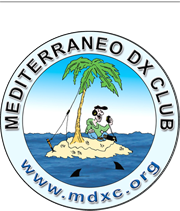

 XT2MD Burkina Faso
XT2MD Burkina Faso

